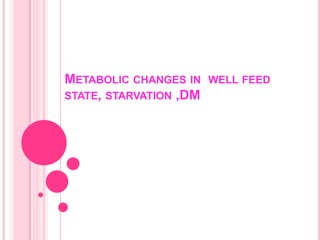
Metabolic changes in well feed state, starvation ,dm
- 1. METABOLIC CHANGES IN WELL FEED STATE, STARVATION ,DM
- 2. METABOLIC CHANGES IN WELL FEED STATE All body cells use glucose for energy. To maintain this constant source of energy, blood glucose levels must be kept between 3.3-6.1 mmol/L Several hormones, help to maintain this level between 3.3-6.1mmol/L, include insulin, glucagon The insulin and the glucagon together maintain a constant level of glucose in the blood
- 3. INSULIN Insulin is a small peptide hormone produced by beta cells of the pancreas Molecular weight of 5808 Da 51 amino acids ,two amino acid chains A and B chains are linked together by two disulfide bonds A chain consists of 21 amino acids and the B chain of 30 amino acids.
- 4. ACTION OF INSULIN ON CARBOHYDRATE, Facilitates the transport of glucose into muscle and adipose cells. Facilitates the conversion of glucose to glycogen for storage in the liver and muscle by ↑ glycogen synthase. Decreases the breakdown and release of glucose from glycogen by the liver by↓ glycogen phospharylase activity.
- 5. ACTION OF INSULIN ON PROTEIN. Stimulates protein synthesis Inhibits protein breakdown; diminishes gluconeogenesis by ↓ pyruvate carboxylases activity ↓PEP carboxkinases. ↓ Fructose 1,6 bisphosphates. ↓glucose 6 phosphates.
- 6. ACTION OF INSULIN ON FAT METABOLISM Inhibition of FFA mobilization from adipose tissue via suppression of lipolysis by inhibiting activity of hormone sensitive lipase Inhibition of plasma FFA uptake and oxidation via suppression of lipolysis Inhibition of hepatic VLDL synthesis Suppression of circulating ketone body concentrations Activation of adipose lipoprotein lipase Stimulation of lipogenesis
- 9. GLUCAGON Alpha cells of the islets of Langerhans ,pancreases. Blood glucose concentration falls. Mol wt of 3485 Da. Large polypeptide ,29 amino acids. Most important of these functions is to increase the blood glucose concentration ,an effect that is exactly the opposite that of insulin
- 10. The major effects on glucose metabolism breakdown of liver glycogen (glycogenolysis) ↑glycogen phosphorylases activity. increase gluconeogenesis in the liver by ↑ pyruvate carboxylases ↑ PEP carboxkinases ↑ Fructose 1,6 bisphosphates ↑ Fructose 1,6 bisphosphates Also involved in stimulating hormone sensitive lipase and promoting lipolysis.
- 12. Glucagon binds to the glucagon receptor,( a G protein-coupled receptor). • conformational change • replacement of the GDP molecule that was bound to the α subunit with a GTP molecule. • releasing of the α subunit from the β and γ subunits. • The alpha subunit specifically activates the next enzyme in the cascade, adenylate cyclase. • cyclic adenosine monophosphate (cAMP), which activates protein kinase A (cAMP-dependent protein kinase). • This enzyme, in turn, activates phosphorylase kinase, which, in turn, phosphorylates glycogen phosphorylase, converting into the active form called phosphorylase A • .Phosphorylase A is the enzyme responsible for the release of glucose-1-phosphate from glycogen polymers.
- 13. METABOLIC CHANGES IN STARVATION Early ,Intermediate, Advance stages of starvation Early stage (2 days) • Glycogenolysis and gluconeogenesis are imp source of blood glucose. • Energy from alternate source (β oxdn FA, KB). Intermediate stage (24 days) • glycogen stores mostly depleted not serve as source blood glucose. • FA ,KB supplied to heart, kidney ,muscles. Advanced stage (>24 days) • KB supplies to heart, kidney ,muscles is decreased , limited to brain only. • Heart, kidney ,muscles on FA as main source. • Gluconeogenesis will enhanced due to increased activity of enzymes pyruvate carboxylase, fructose 1,6 bisphosphates,
- 14. Fig 19.10 19-44
- 15. DIABETES MELLITUS (DM) Figure 16.18
- 17. SUMMARY
- 18. INSULIN GLUCAGON Glucose uptake stimulates Inhibition Glycogenesis stimulates Inhibition Glycogenolysis stimulates stimulates Gluconeogenesis inhibition stimulates Protein synthesis stimulates inhibition Protein degradation Inhibition stimulates Lipolysis Inhibition Stimulates Ketone body Inhibition Stimulates
- 19. THANK YOU
